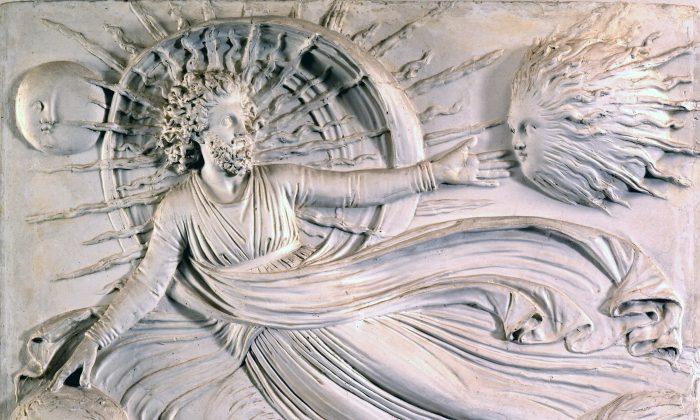NEW YORK—Venetian neoclassicist sculptor Antonio Canova (1757–1822) was best known during his time for his mythological figures executed with purity of feeling and clarity of form. Among his best-known works are “Psyche Revived by Cupid’s Kiss” in the Louvre and “The Three Graces” in the Hermitage.
Born to a family of stonecutters, Canova practiced drawing and sculpting in his youth. He grew up to become something of a legend among his contemporaries.
“He was the first arts administrator for the Vatican—a museum director in a way,” said associate curator Peter Jonathan Bell of the Met’s Department of European Sculpture and Decorative Arts.
Canova was also a diplomat—after the fall of Napoleon, he was sent as the representative from the papal states to reclaim sculptures that Napoleon’s troops had stolen. “He had his hand in just about everything,” Bell said.
Being the man about town, at the end of his life, he financed the building of a church for his hometown of Possagno, 37 miles northwest of Venice. The Temple of Canova is designed to look like a cross between the Roman Pantheon and the Greek Parthenon. (Take a 360-degree look at the temple here)
Crowning the frieze along the top of the church’s porch was supposed to be 32 low-relief images depicting biblical scenes. Canova managed to complete the first seven (a friend said he worked with great rapidity) before he died at the age of 65 in 1822.
As they are, the seven completed reliefs top the entrance to the Temple of Canova, the blank spaces at either end filled in by a repeated decorative motif.
Now, as the Gallerie dell’Accademia in Venice undergoes renovations, it has sent the Met six full-sized, newly restored plaster casts, which represent the penultimate step in Canova’s process of transforming his compositions into final reliefs in stone. The seventh on display comes from the Gipsoteca in Possagno.
These seven plaster reliefs show us what can be done with one or two human figures in a space of no more than 4 feet by 4 feet.
Natural though it is to wish that Canova lived to see all 32 reliefs completed and installed, in a way, his untimely passing leaves the perfect number of reliefs for us to savor up close. A bird in the hand is better than two in the bush—and it’s hard to imagine getting any closer to the mature hand of the artist than through these plaster models.
“We won’t be seeing these reliefs in the United States again in our lifetimes,” Bell said. The plaster models will return to the Gallerie dell’Accademia when renovations are complete.
Genesis and the Birth of Christ
Reliefs one through four depict episodes from Genesis, and five through seven depict events surrounding the birth of Christ.
Canova begins appropriately with “Creation of the World,” in which God, floating in a billowing robe within the cosmos, creates Earth, sun, and moon. The sun and moon have faces—the sun’s is framed in a mane of rays, and the moon’s glows with a serene expression. The whole scene evokes a storybook sense of wonder and fills the viewer with the infinite peace that must have existed when heaven and earth were new.
In the next scene, God creates Adam. With one hand on Adam’s forehead and the other gesturing, God seems to say, “Focus—this will only hurt a bit.” Adam steps backward as the shock of a life-giving force courses through his body.
In this and the other reliefs, Canova amazes viewers with his ability to convey moments of narrative and feeling through body language and facial expression. Perhaps the most powerful example of this is “Cain and Abel.”
Everything in the expressions of these animal skin-clad boys screams with existential angst. As Cain stands over his brother with a crude weapon at the ready, we are able to empathize with both boys (in this rendering, they are mere boys)—Abel can’t help that God approved of his animal sacrifice any more than Cain can understand why God rejected his offering of crops. In Cain’s face we see rage at perceived injustice, pain at incomprehension, and regret for the act that he is about to commit.
Though there are no ready answers for Cain and Abel, the hand of redemption is seen—quite literally—in relief four: “The Sacrifice of Isaac.”
Abraham, to prove his faith in God, is ready to sacrifice Isaac on an altar. At the last moment before knife meets flesh, an angel (here represented by a disembodied hand and a voluminous sleeve appearing from a corner of the relief) stays the blow.
A sheep, as visually out-of-context as the angel’s hand, wanders in from stage right to take Isaac’s place. One can only suppose this peculiar composition works better as seen in an architectural context.
The Virgin Mary carries the last three reliefs. Throughout history she has been represented as a proud, loving, and grieving mother. But here, Canova gives us a woman who is humble, solemn, and forever cognizant of the momentous responsibility God has bestowed upon her.
From receiving the news of her conception from the angel Gabriel with head bowed and hands clasped over her bosom, to presenting the newborn Christ at the temple of God, Canova’s version of Mary not only conveys his personal devotion, but also honors hers.
“There’s not an ounce of ego in these sculptures. It’s stunning when you think about the sculptor and some of his other canonical works, and then are confronted with these powerful spiritual expressions in which he totally effaces himself.” Bell said.
Antonio Canova: The Seven Last Works
Jan. 22–April 27
The Metropolitan Museum of Art
1000 Fifth Ave.
New York, N.Y. 10028
212-535-7710
www.metmuseum.org
Suggested admission $12–$25







Friends Read Free